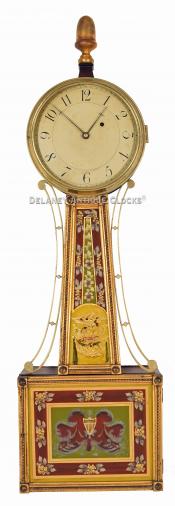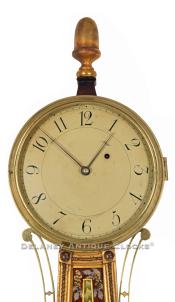Nathaniel Munroe Concord, Massachusetts. A gilt-framed wall timepiece or banjo clock. 221227.
This is a colorful example. The clock case is constructed in mahogany and features gilded rope-fitted frames. All of the gilding is original to this example and is in excellent condition. The wooden acorn-style finial is also gilded. It is mounted onto a shaped mahogany plinth at the top of the case. The bezel is cast in brass and fitted with a convex piece of clear glass which is used to protect the dial. The head of the clock case is constructed with the "Concord-style cut-out." This design cuts enough wood from the interior of the head of the case to mount the movement. This suggests that the case was purchased from Daniel's brother, William Munroe, who was still working in Concord. The glue blocking placement in the interior of the lower box is consistent with other examples signed by this Maker. Brass side arms flank the throat section of the case. These are hand-filed, lightly formed, wonderfully shaped, and pinned to the case in three locations.
The enameled iron dial is a slightly convex shape. It is hand-painted and features an open minute track and Roman-style hour numerals. The hour and minute hands are made of steel. They feature an interesting shape.
Both of the frames are fitted with paint-decorated glass tablets. These eglomise tablets are hand-painted with a very high level of skill and are quite colorful. They are in excellent condition. The lower tablet has been professionally repainted to match the colors of the original throat tablet. The throat tablet is signed by the Clockmaker in the banner located at the bottom. The signature reads, "N. MUNROE."
The time-only weight-driven movement is an eight-day brass construction design. The movement construction features large rectangular-shaped brass plates. The teeth in the gear train are deeply cut. The pendulum is supported by a T-bridge suspension. The movement is mounted to the back of the case with a single screw that is fastened from the back of the case.
This is very attractive Federal Massachusetts Timepiece or 'Banjo clock' was made circa 1815. This clock measures approximately 34 inches long.
Inventory number 221227.
Nathaniel Munroe was born in Roxbury, Massachusetts on June 21, 1777. He learned the skill of clock making from Abel Hutchins of Concord, New Hampshire. It is thought that is apprenticeship was fully served by 1798 and soon joined his brothers Daniel and William in business with between 1798-1804. This first firm was called Daniel Munroe & Company. A fair number of tall case clocks are known signed in this manner. Nathaniel married Sally Lee in Concord in 1803. In 1804 -1807, William Munroe moved on and Nathaniel and Daniel continued to work together. During this period, Nathaniel also opened a shop in Norfolk, Virginia. Here he took part of a shop from a Mr. Chapman at the head of Bank Street. He advertised in 1805 that his business was there. Sally died in Norfolk on November 12, 1806. Nathaniel returned to Concord in 1807 to wed Mary Cotton Ballard in September. This new family moved south to Baltimore, Maryland where Nathaniel Jr. was born in 1811. By 1808, Nathaniel joined Samuel Whiting in business as Munroe & Whiting. Munroe did business in both locations. A New England style tall case clock is known signed by this Baltimore firm. The Munroe & Whiting partnership employed as many as eight apprentices at one time in Concord. The partnership with Whiting lasted until 1817. During this time, Daniel lived for a time in Virginia and Maryland while the firm continued to be run from Concord. In 1817, Nathaniel and Benjamin K. Haggar advertised together as partners in business in Norfolk, Virginia. Their shop was located at 57 South Street. Shortly after this shop was moved to a new address located at 25 North Howard Street and did a healthy business in 8 day clock movements and in clock supplies on a wholesale level to other American dealers. In May of 1818, Munroe advertised having Willard Timepieces for sale. In 1819, he announced moving from Howard Street to 222 Market Street. His second wife, died on May 29 1825. He married for a third time to Mary Ann Haggar on May 16, 1826. She was related to his former partner Benjamin Haggar. In1826 - 1828, Nathaniel forms a partnership with with David Holman as Munroe & Holman. This firm is listed as a spectacle makers or jewelers and silversmiths in the directories. In 1829, Munroe is listed as working alone through 1831 at his old stand on Baltimore Street as a clockmaker and optician. Nathaniel's son Nathaniel Jr. was most likely trained by his father. He moves to Mobile, Alabama and to Selma in 1850. Nathaniel Sr died on May 8th 1861 and is buried in the Green Mountain Cemetery in Baltimore.














